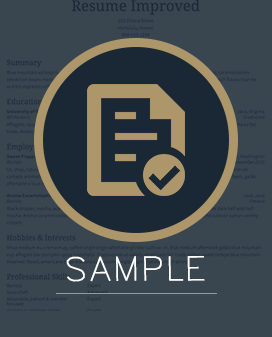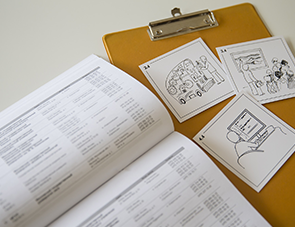Standard Formats
A well-designed resume not only serves the purpose of recapping your skills and past experiences, but looking to the larger picture, is the core componet marketing you as an individual. Beyond simply correcting spelling or grammar mistakes, you must focus on how to best convey your professional identity.
As a means to help you in presenting yourself in the best light possible, experts have categorized resumes into 3 broad categories: functional, reverse chronological, and combination.
- Each type, coming with its own strengths and weaknesses, is designed to tailor to different needs.
CAREER
TIP
Choosing a pleasing, consistent, and information-dense style that matches your application is crucial when creating a resume and our resume builder is directed to help you.
Choosing the Right Option
With reference to choosing a resume, there are a few basic guidelines you can follow along with. Here is a quick overview on the type of professional each resume is aimed towards.

1.The reverse chronological resume emphasizes employment history, designed to focus an employer's attention towards past accomplishments.
- Generally, content is structured with most relavent (and incidentally most recent) positions first, while reserving past positions or experiences further down- hence its naming as "reverse-chronological".
- This option is frequently chosen by those with an upward career trajectory or diverse employment history. Employers generally prefer their applicants to stick with this style, as reflected by the fact that it's most common.
2.The combination resume allows its writer to showcase a multi-faceded view of their application.
- While on the one hand showcasing employment history, the combination resume also incorporates componets of the functional resume through its inclusion of information such as skills, aptitudes, or proficiencies.
- This resume type appeals to individuals whose accomplishments can best be summed up as falling somewhere in the "middle ground" of qualification.
3.The functional resume format, perhaps the most obscure of the three, takes a different approach from listing off achievements or employment history, and rather, focuses exclusively on an applicant's skillset.
- The basic premise behind this resume type is to appeal to your employer logically, letting them know what specifically you can offer to the company by relying less so on the credibility of your past achievements.
- Some employers frown upon this format, as it may be considered to "flower" an applicant's achievements by straying away from factual details.
- The functional resume is recommended for use by employees with large gaps in employment, career changes, or other major setbacks in their employment history. Designed to hide certain details and focus on subjective appeal, as opposed to objective credibility, the functional resume is effective in setting up new opportunities for this class of applicants.
Visual Comparison
| Chronological | Functional | Combination | |
|---|---|---|---|
| Emphasis | Past Emplyoment | Skills | Both |
| Skills | Implied | Elaborated | Elaborated |
| Pros | Preferred by recruiters | Up-sells unqualified candidates | Provides balanced analysis |
| Cons | Lack of emphasis on skills | May fail to establish credibility | Lengthliness may deter employers from reading |
Reverse-Chronological
The reverse chronological resume is best suited for use by professionals with many years experience or whose career has recently upticked its productivity.
- The structure formats most pertinent information towards the top, with less recent and relavent information further down... the concept behind which is that employers only take a few seconds to evaluate a resume, and therefore, the most relavent information should accordingly be displayed first.
Reverse Chronological Resume Samples
A common convention across the listed samples is starting off with a description of your latest or most significant job position. As the list descends, other positions or involvement is elaborated upon further.
The aforementioned styling puts emphasis on what is relavent to managers, thereby saving them time and demonstrating a sense of brevity appreciated by employers.
PROS
Information is clear and consistent
Establishes line of credibility
Preferred method by employers
Paints clear picture of career trajectory
CONS
Inability to showcase diverse skills
Does not account for major career shifts
Objectivity points out career gaps
Lack of elaboration on skillset
The reverse chronological resume format is suited for me if…
- I have experienced in the field to which I’m applying
- My employment history has been consistent and uninterrupted
- My career has progressed vertically
I should avoid using the reverse chronological resume if...
- I'm undergoing a career shift
- I have major gaps in employment history
- I hop around to different positions frequently
Functional
A functional resume contrasts with the chronological format’s emphasis on employment history; rather, it focuses on skills, abilities, and achievements.
- The functional resume is used most prevalently by applicants whose work history is incapable of fully demonstrating their skills. Commonly, those with unordinary or varied employment histories may find the functional resume to be better suited to their purposes.
CAREER
TIP
If your understanding of resume formats is still slightly unclear, consider brushing up on our comprehensive resume basics section, preceding the past two tutorials.
Functional Resume Samples
Whereas the chronological resume paid importance to the time at which each position was held, the functional simply lists its entries according to their relative significance.
The resume samples demonstrate the effectiveness of the functional format in providing evidence of a candidate's strength through a diverse skillset, as well as hiding experience gaps and helping employers to quickly locate relavent information.
PROS
Directly responds to skills needed
Appeal with mixed employment histories
Call-to-action emphasizes commitment
Organized structure is easy to disect
CONS
Lack of credibility associated with skillset
Generally unpreferred by employers
Skillset is unfocused
Scarcity of information seen as deceptive
The functional resume format is suited for me if…
- My career trajectory is not straight-forward
- I am undergoing a career change
- I have a diverse skillset
I should avoid using the functional resume if...
- I’m attempting to demonstrate vertical career progression
- My skillset is narrowed in on a particular industry
- I have not recently undergone any industry shifts

Combination
As indicated by its name, the combination resume incorporates aspects of both the functional and chronological formats.
- The general idea is to maintain an emphasis on skills and accomplishments, while also making use of an easy-to-understand timeline. This way, the applicant can appeal in ways exclusive to the functional resume in addition to conveying a clear and time-stamped overview of their employment history.
Combination Resume Samples
The combination, also referred to as the hybrid, resume is unique through the fact that incorporates mixed aspects of the functional and chronological resume samples.
There is no standard as to whether skills or employment history is elabored first; the positioning will be dependent on whichever the applicant feels emphasizes their strongpoints more deeply.
PROS
Demonstrates well-developed skill set
Provides for emphasis on qualification
Flexibility for diverse employment/skills
Clear timeline conveys trust
CONS
Unsuited for entry-level applicants
Lack of emphasis on education
Length may deter full read-over
Format may come across as disorienting
The combination resume format is suited for me if…
- I am an accomplished professional
- My career history shows some uncertainty
- I have a diverse skillset to promote
I should avoid using the functional resume if...
- I lack either qualifications and skills or employment experience
- I intend to stay in my current industry
- I want to emphasize my educational experience
Alternative Styles
Aside from the 3 most common resume styles, a wide array of other options await applicants with extenuating or otherwise untraditional employment histories. While it's recommended to glance through the following options, we would advise to carefully analyze the other 3 before reaching a decision on which style to select.

Mini Resume:
- A stark contrast to other entries on this list, the mini resume takes the form of only a few hundred word overview, serving the purpose of briefly "catching" an employer's attention.
- Most commonly, the mini resume is formatted on a business card and used for networking. By simply giving this small description to employers, an applicant avoids having to carry out the hassle of sending them a full copy of a resume.
CAREER
TIP
In addition to the tutorials and live builder, the feature resume services section may expedite your resume building endeavors by providing alternative options.
Target Resume:
- Designed to cater to a particular employer, the targeted resume is best suited in situations whence you are set on obtaining a specific job or have the knowledge of what skills an employer is looking for.
- While admittedly a time-consuming alternative, the target resume provides you with the opportunity to voice your hernest and selective interest in a particular position, signifying to your employer your seriousness in applying.
Video Resume:
- The video resume has gained popularity, along with notoriety, as the digital age has dawned over the employment sphere.
- In a similar manner to the 'Mini Resume', the video resume is most commonly used to compliment a traditional, written-out resume.
- The video resume serves as an excellent alternative when attempting to catch an employer's attention, perhaps otherwise by which traditional means would be too unconvincing.
- Through the format of a video, your employer can gague first hand not only what your accomplishments are, but also who you are as a person and how your creativity reflects that.

Core Componets
Contact Information: Let your employer know how to advance the application process
- After all the work of going through and filling out an application, you should make your contact information plainly obvious. If the resume-reviewer has to scroll through several pages to find this crucial detail, they may loose interest in the application altogether.
Summary Statement: Pose a call-to-action to your employer and give them a brief run-down of your past experiences
- The vitality of the summary statement may at first seem obvious, but in many cases, its importance goes understated. Often times, an employer will only take a few seconds reading each application. You need to capture their attention quick and balance their flash-judgement in your favor!
Educational Background: Certify your level of qualification by utilizing the trustedness of a post-secondary degree
- No matter the level of qualification you seek to apply for, citing your educational background may help to add extra credibility to your application. Besides, on the topic of experience, a standard education usually takes 16 or more years to develop. Notify your employers of how you've taken use of this huge portion of your life.

Key Takeaway
The quintessential understanding you should take away from this tutorial is that the resume formatting process is neither straight-forward nor cookie-cutter and easily templated. Your choice of resume is dependent on a variety of factors, the least of which can be summed up in a few hundred word post.
CAREER
TIP
Confident in your understanding of the reusme building process? Experiment with our live resume builder to jumpstart the styling process.
Instead, our recommendation is to seek to understand the nuances behind each different type of resume and how certain aspects may apply to your particular case, while others may not. It is only by finding this "middle-ground" that you'll be able to draft up a resume, truly reflective of you.




